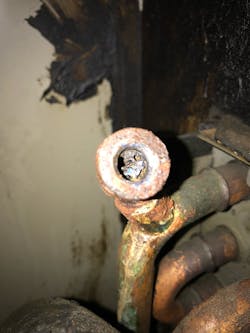I hear that phrase a lot, usually after I explain how something works, after I sketch out some piping, or after I suggest some programming change. Sometimes I catch myself saying it out loud. It’s an easy way to say that you agree, without saying that you had no idea what the problem was.
This job, like others, had some complications. The church accepted the bid to replace their old hot water boiler with two high efficiency mod-con boilers, which is getting pretty routine around here. Building managers like the idea of redundancy, splitting the building heat loss between two or more boilers, so in the case of a boiler failure there is some amount of backup.
This church was built in the 1960’s and there are three zones of heating now. Originally the system must have had a chiller because the fan coils had drain pans and the pipe was insulated right up to the water coils. The current volunteer in charge of the building wasn’t aware of that. They were using lots of window type air conditioning units that he told us needed service.
The hot water to chilled water changeover valves were long gone, so that didn’t complicate the situation. Besides the gas savings, they also wanted to save on the ever more expensive electric bill. Each of the three zones had its own old pump burning up the kilowatts. They had also accepted the variable speed pump option.
To make a variable speed pump work efficiently, the flow has to vary, so this option came with three 1-1/2” motorized zone valves to replace the three zone pumps and a zone valve relay panel to control them. The old boiler kept a reset water temperature all winter long and the pumps cycled on their thermostats, while the combustion air poured in through the open window in the boiler room 24/7.
You’ve seen this before. While the burner is off waiting to hit the bottom of its temperature differential, the cold combustion air is passing through the boiler and up the flue, cooling the cast iron block, whether the pumps are on or not. The burner cycles to keep the water warm, while waiting for the next call for heat, wasting energy when there’s no call for heat.
The new system seals the combustion cycle by closing the window and bringing the combustion air to the burner with the inducer fan only when there is a call for heat. That call is now going to come from the zone valve relay panel, only when one of the zone thermostats senses a chill in the room.
If only one zone is active, then the variable speed pump operates at a low speed to save energy. If all three zones are active, the pump ramps up to maintain enough flow and head to circulate the whole building. Since it’s ECM, it uses about 20% of the energy of the old pumps. Building managers are starting to like that idea too.
Whenever a thermostat seems to be causing a problem, I like to disconnect it and use a jumper on the call, in this case the relay panel. The zone stayed on with the jumper, so the attention now shifted to the thermostat, or its wiring. The wiring checked out in the boiler room, so we went up the stairs to find the thermostat.
This round one looked original to the building, which means a mercury switch and the heat anticipator adjustment. First, we made sure the wiring was snug, then took the adjustment from a very short cycle to the longest cycle. Now, with the thermostat connected back to the relay panel, the call for heat stayed on. Another problem solved, just like we thought.
The real complication on this job was at the initial fill and had nothing to do with high efficiency. The contractor called to say that he couldn’t bleed the air out of one of the zones. He wondered if he had crossed some pipes or done anything wrong to keep the water from filling that zone. I stopped by the next morning on my way to play golf with the Kid and some customers.
Immediately he took me to the sanctuary zone. There were seven of the fan coils in this zone and with the air bleeder valves wide open, the water never came out of any of them. In fact, no air came out either. We went back to the boiler room to check his piping. It was just as I had drawn it up, no crossed pipes or problems. Something was keeping the water from pushing the air out of the open vents.
He hadn’t started on the wiring yet and it was the summer, so we decided to think about this. I went to golf and he went to wire. When he called the next day, I could tell by the tone of his voice that things were better.
He had taken the vent completely off and still no air. See the photo. Turns out that somebody, sometime in the past—with good intentions but bad results—had installed 1/8” black iron street 45 degree elbows on the coil tapping to make it easier to reach the vent.
Then he took the 45 off and still no air, but he could see some sediment. So he shoved a drill bit into the hole until he cleared the path for the air to start bleeding out. All seven were clogged in the same manner.
What a coincidence! Who would have thought that’s possible? When the solution sunk in I said, “That’s what I thought.”
Patrick Linhardt is a thirty-seven-year veteran of the wholesale side of the hydronic industry who has been designing and troubleshooting steam and hot water heating systems, pumps and controls on an almost daily basis. An educator and author, he is currently Hydronic Manager at the Corken Steel Products Co.
About the Author
Patrick Linhardt
Patrick Linhardt is a forty-one-year veteran of the wholesale side of the hydronic industry who has been designing and troubleshooting steam and hot water heating systems, pumps and controls on an almost daily basis. An educator and author, he is currently Hydronic Manager at the Corken Steel Products Co.

